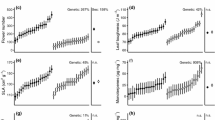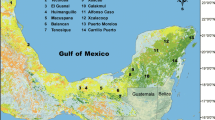Abstract
Character intercorrelation was studied in a natural population of the epiphytic orchid Liparis resupinata in northern Thailand, and patterns of morphological variation in relation to the local growth environment of individual plants were mapped. Massive occurrence of character intercorrelation was detected, but clone size only influenced few characters of individual flowering shoots. Variation in vegetative and floral organs was largely independent, but two cases differed from the general pattern: (1) the only character not defined by size (distance between apices of lateral sepals) exhibited largely independent variation; (2) ovary length was positively correlated with nearly all other characters. Major groups of vegetative and floral characters were found to covary with different combinations of ecological parameters. Although our study does not document the existence of phenotypic plasticity in L. resupinata, the overall patterns observed would be congruent with a scenario involving phenotypic plasticity. No positive correlation between variability and apparent morphological susceptibility to environmental influence was found; but floral characters were generally less variable and covaried with more ecological parameters than vegetative characters. Based on our observations, we make a few methodological recommendations for morphometric studies of species complexes.


Similar content being viewed by others
References
Ackerman JD, Cuevas AA, Hof D (2011) Are deception-pollinated species more variable than those offering a reward? Plant Syst Evol 293:91–99
Adams PB, Burke JM, Lawson SL (2006) Dendrobium speciosum (Dendrocoryne: Orchidaceae) complex in north Queensland. Aust Syst Bot 19:259–271
Atwood JT (1986) The size of the Orchidaceae and the systematic distribution of epiphytic orchids. Selbyana 9:171–186
Averyanov LV (2013) The orchids of Vietnam illustrated survey. Part 4. Subfamily Epidendroideae (tribes Arethuseae and Malaxideae). Turczaninowia 16(1):5–163
Bateman RM, Denholm I (1989) Morphometric procedure, taxonomic objectivity and marsh-orchid systematics. Watsonia 17:449–455
Bateman RM, Denholm I (2003) The Heath Spotted-orchid (Dactylorhiza maculata (L.) Soó) in the British Isles: a cautionary case-study in delimitating infraspecific taxa and inferring their evolutionary relationships. J Eur Orchid 35:3–36
Bateman RM, Rudall PJ (2006) Evolutionary and morphometric implications of morphological variation among flowers within an inflorescence: a case-study using European orchids. Ann Bot 98:975–993
Bernardos S, Crespi A, Del Rey F, Amich F (2005) The section Pseudophrys (Ophrys, Orchidaceae) in the Iberian Peninsula: a morphometric and molecular analysis. Bot J Linn Soc 148:359–375
Caporali E, Grünanger P, Iguera R, Marziani G, Turati S (2000) Morphometric and molecular analyses of some Epipactis taxa in northern Apennines. J Eur Orchid 32:609–621
Chen X, Ormerod P, Wood JJ (2009) 75. Liparis Richard, De Orchid. Eur. 21, 30, 38. 1817, nom. cons. In: Wu Z, Raven PH, Hong D (eds), Flora of China 25. Orchidaceae. Science Press, Beijing and Missouri Botanical Garden Press, St. Louis, pp 211–228
Cresswell JE (1998) Stabilizing selection and the structural variability of flowers within species. Ann Bot 81:463–473
Dressler RL (2005) How many orchid species? Selbyana 26:155–158
Gardiner LM, Hawkins JA, Roberts DL (2005) Species delimitation in Vanda sect. Cristatae Lindl. (Orchidaceae): a morphometric approach. Selbyana 26:347–353
Latta RG (2010) Natural selection, variation, adaptation, and evolution: a primer of interrelated concepts. Int J Plant Sci 171:930–944
Legendre L, Legendre P (1983) Numerical ecology. Elsevier Scientific Publishing Co., Amsterdam
Marcysiak K (2012) Variation of leaf shape of Salix herbacea in Europe. Plant Syst Evol 298:1597–1607
Pearce NR, Cribb PJ (2002) The orchids of Bhutan. Royal Botanic Garden Edinburgh, Edinburgh
Pedersen HÆ (1998) Species concept and guidelines for infraspecific taxonomic ranking in Dactylorhiza (Orchidaceae). Nord J Bot 18:289–310
Pedersen HÆ (2010a) Species delimitation and recognition in the Brachycorythis helferi complex (Orchidaceae) resolved by multivariate morphometric analysis. Bot J Linn Soc 162:64–76
Pedersen HÆ (2010b) Inadequate morphometric analyses have contributed to oversplitting in European orchids: a case study in Dactylorhiza (Orchidaceae). In: Seberg O, Petersen G, Barfod AS, Davis JI (eds) Diversity, phylogeny and evolution in the monocotyledons. Aarhus University Press, Aarhus, pp 193–212
Pedersen HÆ, Hedrén M (2010) On the distinction of Dactylorhiza baltica and D. pardalina (Orchidaceae) and the systematic affinities of geographically intermediate populations. Nord J Bot 28:1–12
Pfennig DW, Wund MA, Snell-Rood EC, Cruickshank T, Schlichting CD, Moczek AP (2010) Phenotypic plasticity’s impacts on diversification and speciation. Trends Ecol Evol 25:459–467
Pinheiro F, de Barros F (2007) Morphometric analysis of Epidendrum secundum (Orchidaceae) in southeastern Brazil. Nord J Bot 25:129–136
Ponsie ME, Johnson SD, Edwards TJ (2009) A morphometric analysis of the Bonatea speciosa complex (Orchidaceae) and its implications for species boundaries. Nord J Bot 27:166–177
Price CA, Weitz JS (2012) Allometric covariation: a hallmark behavior of plants and leaves. New Phytol 193:882–889
Rohlf FJ (1998) NTSYSpc. Numerical taxonomy and multivariate analysis system, version 2.0, user guide. Exeter Software, New York
Schlichting CD (1986) The evolution of phenotypic plasticity in plants. Annu Rev Ecol Syst 17:667–693
Schuiteman A, de Vogel EF (2003) Taxonomy for conservation. In: Dixon KW, Kell SP, Barrett RL, Cribb PJ (eds) Orchid conservation. Natural History Publications (Borneo), Kota Kinabalu, pp 55–68
Seidenfaden G (1976) Orchid genera in Thailand IV. Liparis L.C.Rich. Dan Bot Ark 31(1):1–105
Shipunov AB, Bateman RM (2005) Geometric morphometrics as a tool for understanding Dactylorhiza (Orchidaceae) diversity in European Russia. Biol J Linn Soc 85:1–12
Sneath PHA, Sokal RR (1973) Numerical taxonomy. The principles and practice of numerical classification. W. H. Freeman, San Francisco
Tyteca D, Dufrêne M (1994) Biostatistical studies of western European allogamous populations of the Epipactis helleborine (L.) Crantz species group (Orchidaceae). Syst Bot 19:424–442
van Kleunen M, Fischer M (2005) Constraints on the evolution of adaptive phenotypic plasticity in plants. New Phytol 166:49–60
Vanhecke L (1989) Intraclonal variation and intercorrelation of morphological characters in Dactylorhiza praetermissa: evidence for allometry in Orchidaceae. Mem Soc R Bot Belg II:65–86
Ward DB (1974) The “ignorant man” technique of sampling plant populations. Taxon 23:325–330
Watthana S (2006) The Pomatocalpa maculosum complex (Orchidaceae) resolved by multivariate morphometric analysis. Taiwania 51:1–10
Acknowledgments
We would like to thank Kanok-on Bunpha, Pattarin Nunthamontree, Wuthipong Dongkhamfu and staff of Doi Pha Hom Pok National Park for providing accommodation and assistance in the field, Somran Suddee for useful suggestions and an anonymous reviewer for useful comments on the manuscript. N. Tetsana expresses her gratitude to the Royal Golden Jubilee Ph.D. Program, Thailand, for financial support, whereas H. Æ. Pedersen gratefully acknowledges support from the Augustinus Foundation.
Author information
Authors and Affiliations
Corresponding author
Rights and permissions
About this article
Cite this article
Tetsana, N., Pedersen, H.Æ. & Sridith, K. Character intercorrelation and the potential role of phenotypic plasticity in orchids: a case study of the epiphyte Liparis resupinata . Plant Syst Evol 300, 517–526 (2014). https://doi.org/10.1007/s00606-013-0900-0
Received:
Accepted:
Published:
Issue Date:
DOI: https://doi.org/10.1007/s00606-013-0900-0




